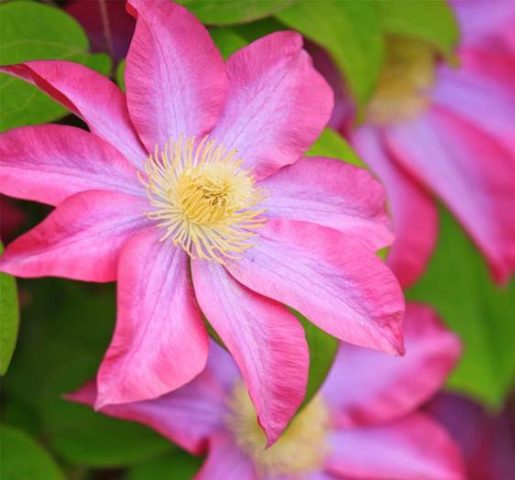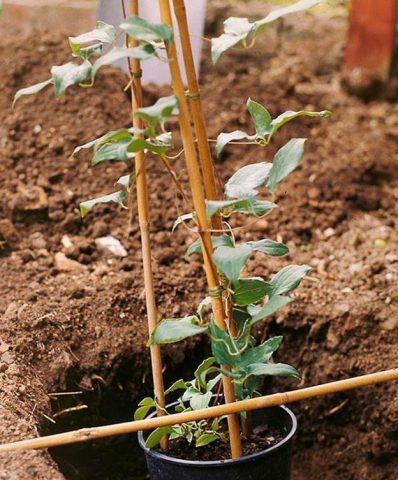Content
Clematis Asao is one of the oldest varieties bred by the Japanese breeder Kaushige Ozawa in 1977. It appeared on European territory in the early 80s. Refers to early flowering, large-flowered clematis. Lianas cling well to supports, they are used for vertical gardening of the garden in the summer. Asao flowers are moderately growing, suitable for container growing.
Description of clematis Asao
Clematis Asao vines reach a length of 3 m.Flowering occurs in 2 stages:
- first - from May to June on the shoots of the last year;
- second - from August to September on the shoots that appeared in the current year.
The flowers form large, simple or semi-double, with a diameter of 12 to 20 cm. Sepals form a lanceolate or elliptical shape with pointed edges, in an amount of 5 to 8 pcs. Below is a photo of clematis Asao showing its two-tone color: white in the middle, in the form of a strip and deep pink along the edge. The stamens are large, yellow or yellow with green.
Frost resistance of hybrid clematis Acao belongs to zones 4-9 and means that the plant can withstand maximum winter temperatures of -30 ... -35 ° C. But these indicators relate to the preservation of roots, and the remaining aerial shoots need quality shelter. Otherwise, reviews of clematis large-flowered Asao describe the plant as unpretentious.
Clematis pruning group Asao
Clematis Asao, like most Japanese varieties, belongs to the 2nd pruning group. To get early flowering with the largest and semi-double flowers, the shoots of the current year must be preserved. In autumn, about 10 of the most developed stems are left, shortening them to a height of at least 1 m from the ground. They are protected for the winter period, the best way is an air-dry shelter.
Growing conditions for clematis Asao
According to the photo and description, the growing conditions for large-flowered clematis Asao differ from other large-flowered varieties. Clematis Asao does not tolerate constant exposure to direct sunlight on vines. Therefore, it is planted in well-lit areas, but with the possibility of shading at noon.
The base and roots of the plant, like other clematis, should be in constant shade. For this, low-growing annual flowers are planted at the base of the plants. Clematis are often grown together with roses. To do this, when planting, their root systems are separated by a barrier.
Over the years, the plant grows a large amount of green mass, so it needs a reliable support. When grown against walls and fences, an indent of 50 cm is made. The vegetative part should not get rainwater from the roof.
Soils for clematis Asao are light, fertile and with good water permeability, neutral acidity.
Planting and caring for clematis Asao
The beginning of the growing season in Asao clematis is early. Spring planting is carried out on dormant buds, which is more suitable for regions with warm spring. In colder regions, Clematis Asao is best left in planting containers until autumn. At this time, the root system is active and the plants root well in a permanent place.
Selection and preparation of the landing site
Clematis Asao is planted in areas with a groundwater level below 1.2 m. Sandy or heavy soils are improved by mixing them with humus and peat. Rotten manure and complex mineral fertilizers are applied to poor soils. Strongly acidic soils are limed. Before planting, the earth is deeply dug up and loosened.
When choosing a site, the planting area is laid with a margin, taking into account the growth of clematis and the fact that the ground around the plant cannot be trampled. Distances between individual plants are maintained at 1 m.
Seedling preparation
The root system of the seedling is inspected before planting. It should have more than 5 healthy, well-developed roots. Bulges on the roots indicate nematode damage, such plants should not be planted. For disinfection, roots are sprayed with fungicide solutions.
If the seedling started to grow while in the container, planting is carried out only after the lignification of the shoots, pinch the growth point. If the seedling has a long shoot at the time of planting, it is cut off by one third.
Landing rules
For planting clematis Asao, a deep and wide planting pit is prepared, measuring 50-60 cm on all sides. The excavated soil is then used to fill the hole.
The excavated soil is filled with 10 liters of compost or humus, 1 tbsp. ash and 50 g of superphosphate and potassium sulfate.
Landing plan:
- At the bottom of the planting pit, 15 cm of drainage is poured.
- Add some of the prepared fertilized soil, covering it with a mound.
- A seedling is released into the planting hole so that the center of tillering is deepened by 5-10 cm.
- A sand-ash mixture is poured onto the center of the root system.
- The planting hole is covered with the remaining soil mixture.
- During the season, the soil is gradually poured up to the general soil level.
Recessed planting is important for the formation of a strong tillering center and plant vitality. In the soil in the center of tillering, new buds develop, from which new shoots are constantly formed. A deep planting keeps roots in frosty winters and from summer overheating.
Watering and feeding
Clematis is picky about soil moisture, especially in the summer, when a large volume of leaf apparatus must be supplied with moisture. With sufficient watering, the plant tolerates high temperatures well, the leaves do not overheat.
In the middle lane, it is watered once every 5 days, in the southern regions more often. Watered only with warm water, preferably rainwater.
Water is poured not under the root, but in diameter, retreating 25-30 cm from the center of tillering. But the best way to water clematis Asao is underground, so moisture does not get on the leaves, does not erode the root zone. Also, drip irrigation prevents the soil from drying out and reduces the risk of fungal diseases.
Mulching and loosening
Loosening is carried out after watering or precipitation, on wet, but not wet soil. Loosening with garden tools can damage delicate shoots and roots. Therefore, in order to keep the soil loose, mulching is used. On the covered soil, a soil crust does not form, so there is no need for constant loosening.
Peat, humus, compost are applied to the soil as a protective layer. Special coconut tree trunks or wood chips are also good materials. Materials and substrates are laid out without affecting the base of the shoots. It is not recommended to use straw or leaves as mulch, due to the possibility of rodents in them.
Pruning large-flowered clematis Asao
The first pruning is carried out after planting, leaving 2/3 of the shoot. Re-pruning is carried out the next year before budding begins. When hiding in the first winter, the shoots are cut off completely.
In the future, clematis Asao is formed according to the 2nd pruning group. Dry and broken shoots are removed throughout the growing season. Pruning is carried out with a clean, disinfected instrument so as not to introduce infection.
Preparing for winter
Before sheltering, the stems and soil under the bushes are freed from foliage, sprayed with copper-containing preparations. At the onset of the first frost, the plant is cut off, the remaining shoots are removed from the support and very carefully rolled up in a ring.
Spruce branches are placed under the stems and on top, the tillering zone is covered with dry sand. Arches or other frame are installed over the plant and covered with a film. For shelter, do not use black material so that the plants do not overheat. The covering material is fixed, a gap is made from below for the passage of air.
In spring, the shelter is removed gradually so that recurrent frosts do not damage the kidneys. Clematis Asao starts growing early, so late removal of the shelter can also destroy the shoots that have appeared. In the future, reserve buds will sprout, but flowering will be weak.
Reproduction
Clematis Acao is propagated vegetatively using different parts of the plant.
Breeding methods:
- By cuttings. Planting material is taken from 2-3-year-old clematis during the budding period. The stalk is cut from the middle of the stem, it should contain: one node, developed leaves and buds. On the handle, 1 cm of the stem is left above the node and one leaf. The cutting is rooted vertically in a container with wet sand, deepening by 5 cm.
- Layers. To do this, the stem is freed from the leaves, pressed against the soil, covered with a sand-ash mixture, watered. After a month, a new shoot appears from each bud, which is cut off from the mother's stem and grown separately.
- By dividing the bush. The method is suitable only for mature and strong bushes. To do this, the plant is completely dug up and the rhizome is divided with a sharp tool into independent parts, where the shoot and buds are present.
For clematis, the seed propagation method is also used. It is less popular due to the fact that in many growing regions the seeds do not have time to ripen.
Diseases and pests
Clematis Asao, when grown properly, rarely suffers from disease. But one of the dangerous diseases is wilt - infectious wilting. It is caused by soil fungi that spread through the vessels and block the flow of moisture to the plant.
The wilting does not lend itself to treatment, the infected shoots are immediately removed, the place is sprayed with fungicides. In this disease, the plant is not completely damaged and subsequently forms healthy shoots.
To prevent the appearance of pathogenic microflora during planting, the soil around the clematis is sprinkled with a mixture of sand and ash. The sand is pre-disinfected. Every year, at the beginning of the season, the soil at the place of cultivation is limed.
More rarely, clematis is affected by powdery mildew, rust and ascochitis, but the appearance of diseases causes great harm to the culture. To prevent their occurrence, clematis is sprayed with copper-containing preparations in the spring before flowering.
A serious pest of the plant is the nematode. It can be detected by the swelling on the roots and the gradual wilting of the vines. There is no cure, the plants must be destroyed, then they are not grown in the same place for 4-5 years.
Conclusion
Clematis Asao of Japanese selection is distinguished by delicate flowering, large volume of leaves. The first flowering is more intense, occurs on the shoots of the last year, the second begins at the end of summer and, depending on the growing region, can continue until autumn. According to the photo and description, clematis of the Asao variety is easy to care for, but demanding for winter shelter.











